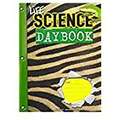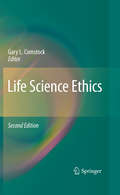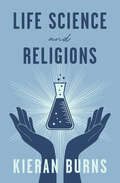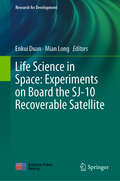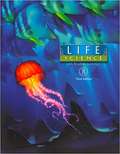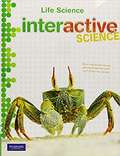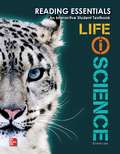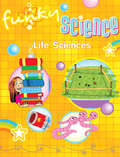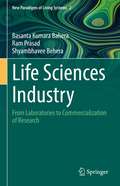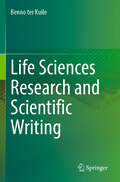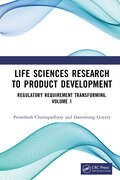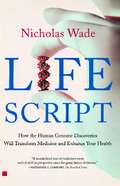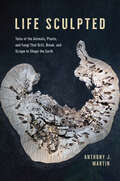- Table View
- List View
Life Science 2: What Is Going On Inside Me? (IQWST)
by Joseph Krajcik Brian ReiserNIMAC-sourced textbook
Life Science 7: Student Guide Part 1
by The Editors at the K12 Inc.Part 1 covers these units: Organisms, Cells, Living Systems along with Semester Assessments.
Life Science Daybook
by Great Source Education GroupThe units of this book explain Cells, Heredity, Diversity and Change, Living Things, Human Body Systems, and Ecology.
Life Science Ethics
by Gary L. ComstockDoes nature have intrinsic value? Should we be doing more to save wilderness and ocean ecosystems? What are our duties to future generations of humans? Do animals have rights? This revised edition of "Life Science Ethics" introduces these questions using narrative case studies on genetically modified foods, use of animals in research, nanotechnology, and global climate change, and then explores them in detail using essays written by nationally-recognized experts in the ethics field. Part I introduces ethics, the relationship of religion to ethics, how we assess ethical arguments, and a method ethicists use to reason about ethical theories. Part II demonstrates the relevance of ethical reasoning to the environment, land, farms, food, biotechnology, genetically modified foods, animals in agriculture and research, climate change, and nanotechnology. Part III presents case studies for the topics found in Part II.
Life Science Student Lab Manual
by Elizabeth A. Lacy Jeff S. FosterIncorporates activities into reading and learning the concepts discussed in class. This mainly involves lab manual applications and investigations.
Life Science and Religions
by Kieran BurnsAn investigation of life science and world religions, and how the two intersect. In Life Science and Religions, Kieran Burns uses Christianity&’s story of the fall of Adam and Eve and the curse of painful childbirth as a starting point to explore the relationship between religion and life science. Over the course of this study, Burns covers Buddhism, Christianity, Confucianism, Hinduism, Islam, Judaism, and Taoism. He discusses topics such as evolution, human suffering, and the notions of healing and perfection. He even looks at what science has to say about spiritual apparitions like Our Lady of Zeitoun, Our Lady of Guadalupe, and Our Lady of Lourdes. This thought-provoking study is sure to interest both students and armchair scholars.
Life Science for Christian Schools (Grade 7, 2nd Edition)
by David R. Anderson William S. Pinkston Jr.Life Science for Christian Schools is a middle-school textbook written for Bible-believing Christians. Those who do not believe that the Bible is the inspired, inerrant (in EHR unt) Word of God will find many points in this book puzzling. This book was not written with such people in mind.
Life Science for Middle School
by Barbara Ferrier Timothy Eimer Cheryl HoogewindThe following topics are covered in this curriculum: Life, Viruses, Bacteria, Protoctists, and Fungi, Plants, Animals, The Human Body, Genetics and Heredity, and Ecology.
Life Science in Space: Experiments on Board the SJ-10 Recoverable Satellite (Research for Development)
by Enkui Duan Mian LongThis book presents the life science experiments in a space microgravity environment conducted on board the SJ-10 recoverable satellite, which was launched on April 6th 2016 and recovered on April 18th 2016. It covers 10 scientific projects in radiation biology, gravitational biology and biotechnology that were selected from ~100 proposals from various institutions in China and around the world. Primarily exploring the rhythm of life in a space microgravity environment, all of the experiments – conducted on nine payloads of the SJ-10 satellite – have never been previously conducted in the respective fields. In addition, the book provides extensive information on the mission’s execution, data collection, and scientific outcomes.
Life Science: Book B
by Brad R. Batdorf Thomas E. PorchA thorough overview of the life sciences but now in two volumes with larger format and single-column text. Activity pages with color illustrations and photographs are included in back of student text. <P><P>Objectives are listed at the beginning of each section, and self quizzes are at the end of each chapter in addition to regular review questions. <P><P>There is increased emphasis on Bible integration as well as career features, increased compliance with national and state science standards, enhanced appendices on classification and biomes, and an expanded glossary and index
Life Science: Grade 4 (Scott Foresman Science, 2003)
by Scott ForesmanScott Foresman Science (2003) components for Grade 4.
Life Science: Guided Reading and Study Workbook (Science Explorer: Life, Earth And Physical Science #Student Edition)
by Prentice-Hall StaffScience Explorer Life Science Guided Study Worksheets Se 2001c
Life Science: Interactive Science, Grade 7
by Prentice-Hall Staff<p>Interactive Science: Grade 7 is the next step in your child's Science homeschool programs. All levels of Interactive Science include hands-on activities, exciting labs and engaging topics sure to help your child find enjoyment in learning. This curriculum for homeschooling is unlike any other in that it helps you design dynamic lessons that meet educational goals. <p>Using the materials included in Interactive Science: Grade 7, you'll be able to craft lessons that will solidify your child's foundational Science knowledge. The best part is that he or she is sure to find excitement in the journey! <p>Interactive Science is a flexible program that allows you to work at your child's pace and incorporate all the curriculum's more hands-on offerings. <p>Because your child is at the middle school level, he or she needs a challenging Science program. Interactive Science: Grade 7 simultaneously reiterates important foundational information and helps your child progress.
Life Sciences Funky Science (Funky Science)
by Kirsten HallSmart and savvy girls will love discovering the secrets of science! Funky Science: Life Sciences has loads of cool, creative experiments presented in a fun and accessible way, relating to topics that girls love. Check out all sorts of cool critters, become besties with bugs, sing with the birds, take the taste test, and walk on the wild side with Life Sciences! All experiments are developed with science teachers and provide the science behind the activity along with parental guidance symbols and glossaries of Wonder Words.
Life Sciences Industry: From Laboratories to Commercialization of Research (New Paradigms of Living Systems #2)
by Ram Prasad Shyambhavee Behera Basanta Kumara BaheraBasic principles of applied life sciences such as recombinant DNA technology is used in most life sciences industries marketing bio-formulations for designing more effective protein-based drugs, such as erythropoietin and fast-acting insulin etc. In recent times genetically engineered host cells from mammal, animal and plants are also being used in life sciences industries to manufacture biologics. This book discusses the most basic as well advanced issues on biological products for successfully managing a life sciences industry. It elucidates the life cycle of biological molecules, right from the conceptual development of different types of biopolymers, and their subsequent transfer from the conical flasks in laboratory to life sciences industries for large scale production and marketing. It focuses on sustainable longevity in the life cycle of commercial biopolymers. Cumulative facts and figures in this volume would immensely help in inspiring life sciences industry promoters to monitor value chain transfer process of biologics for better profitability. Additionally, it would serve as a perusal document for the students and researchers interested in entrepreneurial ventures or having their own start-up projects for the commercialization of biologics.
Life Sciences Research and Scientific Writing
by Benno ter KuileScientific writing is a trade that can and must be learned and not a form of art that is limited to the talented. The real constraint for writing a good scientific article is most of the time not the usage of the English language, but the conversion of outcomes of a set of experiments into a coherent and convincing scientific story. This book is designed to guide junior scientists in the Life Sciences writing their thesis and first manuscripts, along this uphill struggle. All aspects of building up and publishing a forceful scientific narrative are covered, from designing experiments to dealing with the reviewers’ comments. This book takes you step by step through the process of writing a paper. It starts by discussing how to collect and organize data and make an outline. The actual writing starts with the Results section, as this is the heart of any research paper. The Discussion interprets your data in the framework of the existing literature and explains the novel insights you obtained. The Introduction is written to pose the questions that are answered in the Discussion and give the necessary background information. It is written after the Results and Discussion to make sure it is a perfect match. The M&M is the easiest to write. A good abstract is essential for attracting readers. How to write that is described in detail. The title is the last piece of the puzzle. The book contains many practical examples that explain the general principles of good writing. These examples are all from the Life Sciences and so are the anecdotes that illustrate the concepts, making the information directly applicable. All kinds of tips and suggestions are provided for improving readability and accessibility of your manuscript, thus making it easier acceptable. In addition, background information on the basics of science is supplied that helps to avoid common mistakes that cause rejection of manuscripts that report on otherwise good science.
Life Sciences Research to Product Development: Regulatory Requirement Transforming, Volume 1
by Pronobesh Chattopadhyay Danswrang GoyaryThe present volume, Life Sciences Research to Product Development: Regulatory Requirement Transforming, Volume 1, discusses the procedures of drug approval and regulatory requirements that must be met according to the United States Food and Drug Administration (US FDA), the European Medical Agency (EMA), and the Central Drug Standard Control Organization (CDSCO). Many researchers either abandon their work in the middle of the process or find it difficult to follow the rules. Therefore, it is not surprising that any biological researcher associated with drug development should have a thorough understanding of regulatory requirements. This volume incorporates all the requisite regulatory norms and provides the latest information on the mandated regulation of herbal medicines.The book covers other obligatory regulatory requirements such as: The legal method and practice of herbal drug products, the roles of Ayurvedic medicines, and the process to obtain regulatory approval. Drug molecules not included in Department of Ayurveda, Yoga, Naturopathy, Unani, Siddha, and homeopathy (AYUSH) but referred to as phytopharmaceuticals are also considered new drugs. The boundary line between food and herbal pharmaceuticals is discussed, as well as pre-clinical toxicity testing, clinical trials, and stability studies in accordance with the rules. The chapter on regulatory implications for the approval process in this book will be the most useful resource for researchers and students, particularly those with backgrounds in pharma, forensic medicine, or regulatory affairs, or those who aspire to succeed in drug research. Additionally, the information contained in this volume of the book could be of great interest to researchers working in the herbal drug industry.
Life Script
by Nicholas WadeWith the decoding of the human genome, researchers can now read the script in which evolution has written the program for the design and operation of the human body. A new generation of medical treatments is at hand. Researchers are developing therapies so powerful that there is now no evident obstacle to the ancient goal of conquering most major diseases. Nicholas Wade has covered the sequencing of the genome, as well as other health and science stories, for The New York Times, in the course of which he has interviewed many of the principal researchers in the field. In this book he describes what the genome means for the health of present and future generations. Someday soon physicians will have access to DNA chips that, from a drop of blood, will screen a person's genes for all the diseases to which he or she may be genetically vulnerable. From full knowledge of the instruction manual of the human body, provided by the genome, pharmaceutical companies hope to develop a new generation of sophisticated drugs; one of the first genome-derived drugs is already undergoing clinical trials. Another vital tool will be regenerative medicine, a new kind of therapy in which new organs and tissues will be grown from a patient's own cells to replace those that are old or diseased. With the help of DNA chips, medical researchers will soon be able to diagnose diseases such as cancer much more precisely and to tailor specific treatments for each patient. Individualized medicine will also become an important part of the pharmaceutical world. Many drugs will be prescribed based on information from DNA chips that identify which of a range of drugs is best for each patient, as well as which drugs are likely to cause side effects. The medicine of the post-genomic era will be customized for a patient's genetic make-up, providing treatments based on a precise understanding of the mechanism of disease. Life Script describes a future in which good health, even perfect health, may become the standard for everyone -- at every age.
Life Sculpted: Tales of the Animals, Plants, and Fungi That Drill, Break, and Scrape to Shape the Earth
by Anthony J. Martin"There is much to love between this book’s covers. . . . There are many eureka moments in Life Sculpted—and some truly beautiful ones."—Eugenia Bone, Wall Street Journal Meet the menagerie of lifeforms that dig, crunch, bore, and otherwise reshape our planet. Did you know elephants dig ballroom-sized caves alongside volcanoes? Or that parrotfish chew coral reefs and poop sandy beaches? Or that our planet once hosted a five-ton dinosaur-crunching alligator cousin? In fact, almost since its fascinating start, life was boring. Billions of years ago bacteria, algae, and fungi began breaking down rocks in oceans, a role they still perform today. About a half-billion years ago, animal ancestors began drilling, scraping, gnawing, or breaking rocky seascapes. In turn, their descendants crunched through the materials of life itself—shells, wood, and bones. Today, such “bioeroders” continue to shape our planet—from the bacteria that devour our teeth to the mighty moon snail, always hunting for food, as evidenced by tiny snail-made boreholes in clams and other moon snails. There is no better guide to these lifeforms than Anthony J. Martin, a popular science author, paleontologist, and co-discoverer of the first known burrowing dinosaur. Following the crumbs of lichens, sponges, worms, clams, snails, octopi, barnacles, sea urchins, termites, beetles, fishes, dinosaurs, crocodilians, birds, elephants, and (of course) humans, Life Sculpted reveals how bioerosion expanded with the tree of life, becoming an essential part of how ecosystems function while reshaping the face of our planet. With vast knowledge and no small amount of whimsy, Martin uses paleontology, biology, and geology to reveal the awesome power of life’s chewing force. He provokes us to think deeply about the past and present of bioerosion, while also considering how knowledge of this history might aid us in mitigating and adapting to climate change in the future. Yes, Martin concedes, sometimes life can be hard—but life also makes everything less hard every day.
Life Sculpted: Tales of the Animals, Plants, and Fungi That Drill, Break, and Scrape to Shape the Earth (Emersion: Emergent Village Resources For Communities Of Faith Ser.)
by Anthony J. MartinMeet the menagerie of lifeforms that dig, crunch, bore, and otherwise reshape our planet. Did you know elephants dig ballroom-sized caves alongside volcanoes? Or that parrotfish chew coral reefs and poop sandy beaches? Or that our planet once hosted a five-ton dinosaur-crunching alligator cousin? In fact, almost since its fascinating start, life was boring. Billions of years ago bacteria, algae, and fungi began breaking down rocks in oceans, a role they still perform today. About a half-billion years ago, animal ancestors began drilling, scraping, gnawing, or breaking rocky seascapes. In turn, their descendants crunched through the materials of life itself—shells, wood, and bones. Today, such “bioeroders” continue to shape our planet—from the bacteria that devour our teeth to the mighty moon snail, always hunting for food, as evidenced by tiny snail-made boreholes in clams and other moon snails. There is no better guide to these lifeforms than Anthony J. Martin, a popular science author, paleontologist, and co-discoverer of the first known burrowing dinosaur. Following the crumbs of lichens, sponges, worms, clams, snails, octopi, barnacles, sea urchins, termites, beetles, fishes, dinosaurs, crocodilians, birds, elephants, and (of course) humans, Life Sculpted reveals how bioerosion expanded with the tree of life, becoming an essential part of how ecosystems function while reshaping the face of our planet. With vast knowledge and no small amount of whimsy, Martin uses paleontology, biology, and geology to reveal the awesome power of life’s chewing force. He provokes us to think deeply about the past and present of bioerosion, while also considering how knowledge of this history might aid us in mitigating and adapting to climate change in the future. Yes, Martin concedes, sometimes life can be hard—but life also makes everything less hard every day.

